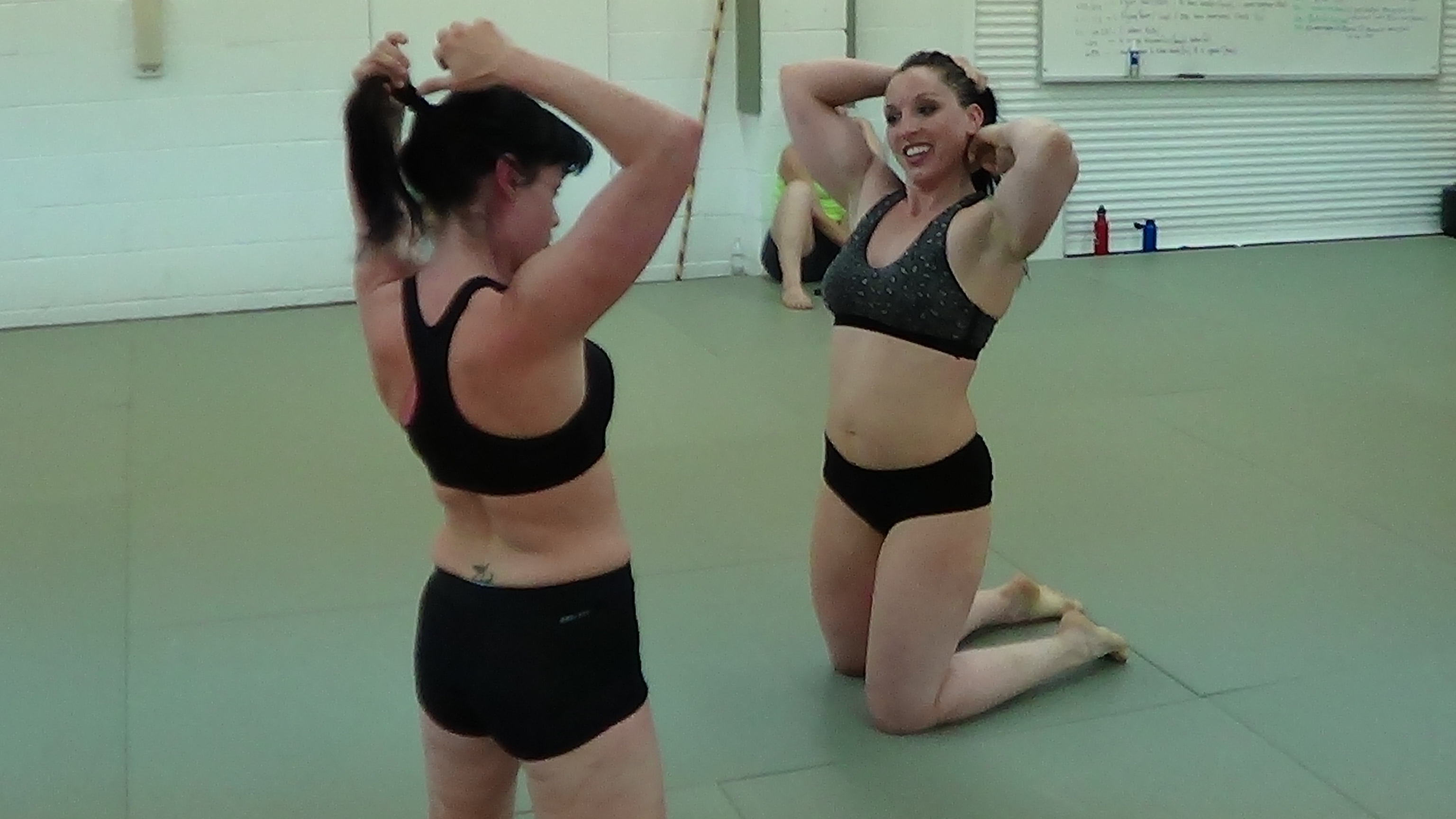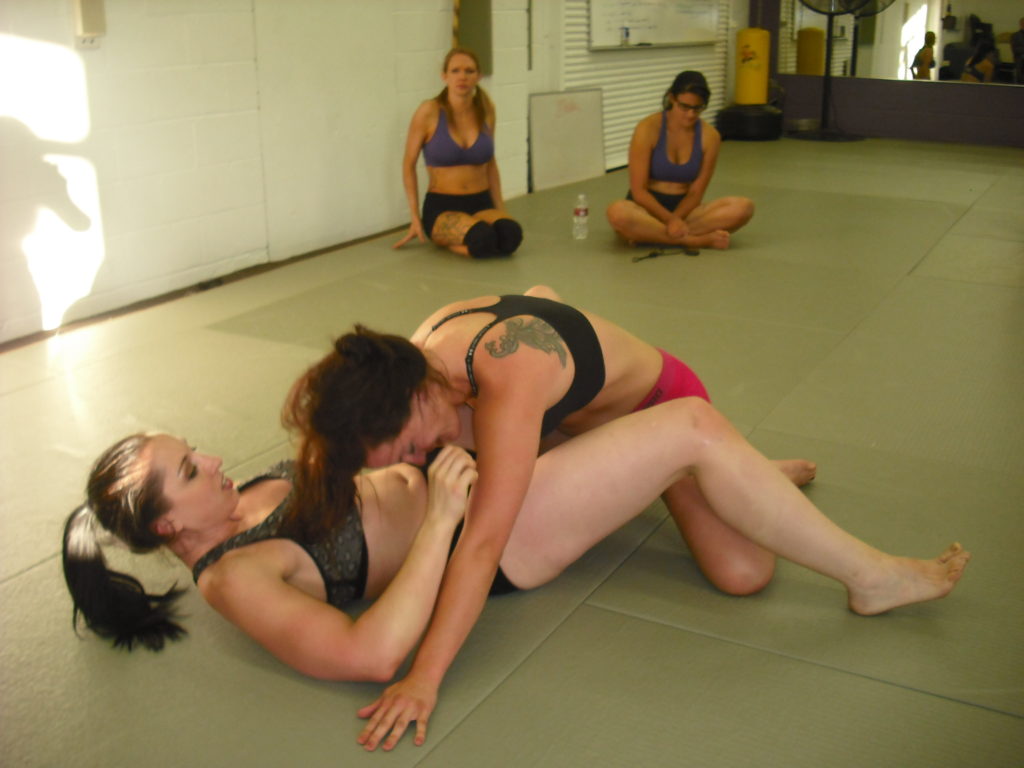
fciwomenswrestling.com article, https://femcompetitor.com photo
Female Submission Wrestlers who take their craft seriously can benefit from the same principles that apply in other fiercely competitive sports environments.

After you have taken strong steps to achieve top conditioning, exceptional training and much needed important skillsets from MMA mentors, there is still is another extremely important step to take before you even leave home.
You must begin to visualize yourself as a champion.
“Dare to visualize a world in which your most treasured dreams have become true.”…Ralph Marston
The legendary Tennis Coach Nick Bollettieri has successfully participated in the development of many leading players, including Andre Agassi, Jim Courier, Monica Seles, and Mary Pierce.
Mr. Bollettieri once said something that greatly affected this writer’s ability as a former United States Tennis Official and Female Tennis Coach here in Northern California to dramatically change the fortunes of a high school female tennis player.
In her sophomore and junior years, her varsity won-loss records were 4-10 and 3-11 respectively.
She then asked me to coach her for her senior year to help her earn a scholarship.
In the United States, the most closely watched markets for female high school tennis are Florida and California.
Why?
Great year round weather.
If you can be a champion there, with straight A’s and AP classes on your resume, you are almost guaranteed a scholarship.
Here is the reasoning behind that.
Most high school students in the East, South and Mid-West want to go to college where?
Virtually year round sunny California and her magical beaches.
Who can resist the almost year round parties, sun and fun?
So if you are a top female tennis player in California with the above described grades, you can almost write your ticket and go to great Mid-West schools that have tennis programs.
So after a summer of training everyday with no days off, and like football, double sessions on the weekends, when her senior season began, she raced off to a 5-0 start.
Now, as a girl in the public school system, after upsetting the private school in a 3 hour knockdown drag out affair in the hot sun, she ascended to a shocking 6-0 record.
Now for the point.
I began to program her that now that she beat the private school, according to Mr. Bollettieri’s formula, you must defeat the people that you are supposed to defeat and hope to beat the champion at least once. Do that and you are on your way to a championship season.
Stated another way?
Even though she wasn’t even one of the top 6 seeds on her own team last year, after upsetting the champion, she had now become the champion until someone defeats her.
From there she surged to a 13-0 record against experienced club and USTA players with far more hardened varsity experience than she had.
Once she reached the upper echelon of her city, including the playoffs, she finished the year with an impressive 16-4 record, fought in her league’s final four, led her high school to the playoffs for the first time in their school’s history and was named team MVP.
Oh by the way, she received a full ride scholarship out of state.
For those of you who take the female submission wrestling game seriously, after extensive training, this is an extremely important next step.
This is especially important for the company fighters that proliferate in our industry who have gotten used to a certain pecking order in their circle.
In a February 2016 article in psychologytoday.com, they reiterate, “What do resilient leaders and Olympic athletes have in common?
They both leverage visualization to manage competition in ambiguous times.
Many of the world’s most elite athlete’s utilize a “mental gym” technique to visualize their successes as a compliment to their physical training. And not without reason: this kind of visualization has very physical results. One study from 2004 published in Neuropsychologia showed that success visualization increased muscle strength in participants by 35% over a control group.”
At Femcompetitor Magazine, while we have achieved great success at the elite high school sports level, it’s always helpful to listen to information from others who earned success at higher levels.
On the subject of Sports Psychology, we would like to turn our attention to a guest writer.
Mental Preparation for Peak Performance
by: John Ellsworth
Depending on whom you talk with, whether they be a coach, player, sports agent, or parent, you will hear that the mental component of sport performance ranges from having as little as 10% significance to as great as 90% of the performance curve.
Measuring success is a difficult task because achieving exactness in performance is quite challenging. However, if even the smallest percentage of one’s performance can be attributed to mental preparation one would think an athlete might consider implementing a mental game strategy to achieve that extra performance edge.
There are a number of techniques an athlete has at their disposal to strengthen the mental aspects of their performance. This article will introduce two of the more popular methodologies for improving one’s mental game. The best technique is the one that helps the athlete achieve the performance levels they aspire to. Should you require any further information or wish to learn more about how to implement any one of these strategies, please email me at john@protexsports.com.
IMAGERY
Imagery in sport is essentially the re-creation of an experience that resembles the actual physical experience without actually performing the physical execution of the skill. The re-creation and sensory feeling of skill execution can be accomplished through verbal rehearsal (repeating out loud the individual task elements associated with execution of a skill), or by creating vivid sensory specific images of each element or step associated with execution of the skill.
For example, in the overt execution of a skill the muscles receive sensations associated with the actions related to task execution. However through imagery, all sensations experienced by the physical act of performing are actually recreated in a “frame of reference” by using the senses to re-live the experience. Everything is executed in a passive way by imagining or visualizing the actual performance as if it were actually happening.
By recreating the experience in the mind’s eye the athlete can actually experience the same feeling as if the overt execution were truly happening. Research suggests that mental rehearsal actually helps athletes prepare for competition almost as equally well as executing the physical skill.
AROUSAL MANAGEMENT
An athlete’s arousal (excitement) level has a direct impact on their performance. Research has shown that performance does increase as arousal increases up to a certain point, then performance begins to decrease somewhat dramatically. If arousal levels are too low consequently motivation and desire may not be optimal to support a quality performance effort. On the other hand, if arousal levels are too high it is likely the athlete will make mistakes and errors and once again not achieve the optimal levels of performance.
Each athlete will require a specific level of arousal level to maximize their performance. For example, a baseball batter will require lower levels of arousal to perform the skills necessary to execute on hitting the pitch. They should have very low anxiety levels when they step into the batter’s box. The hitter should have high levels of confidence and trust in their skills, with a narrow range of focus for successful execution to occur. Higher levels of arousal will cause the hitter to make decisions about pitches they would not otherwise make. On the other hand a basketball point guard on offense will need a higher level of arousal, as the situation requires them to be more active, yet they still must be able to run the desired offense effectively. Arousal levels will increase even more when the basketball players is asked to play defense.
Higher than optimal arousal levels for a particular skill may cause the athlete to become too anxious and begin to worry too much about the results rather than focus on the required task. As anxiety increase so does muscle tenseness and therefore physical and mental flexibility becomes hindered. Precision movements require flexibility as well as unconscious and automatic thoughts about play action. A point guard forcing a pass to the post under the basket might happen if arousal levels are too high. A baseball hitter might swing at a pitch out of the strike zone if anxiety to perform gets in the way of execution. If each of these athletes exhibit below normal arousal levels, they may lack the energy to perform a task. Specific techniques that can help an athlete be in control of arousal levels are:
• The use of a pre-execution routine to center and focus energy on the task.
• The use of breathing techniques to reduce stress and anxiety.
• The use of positive self-talk in support of previous success.
CONCLUSION
Success comes from repetitive task achievement. Task achievement comes from having a focused and committed practice plan. The best practice plan incorporates mental preparation techniques supporting arousal control strategies as discussed above. A well rounded practice plan coupled with appropriate coaching and immediate constructive feedback will indeed build confidence and improved performance.
Just like technical skill mastery, mental skill mastery is achieved one small skill at a time. Create, implement, and practice one skill per day or per week until confidence or mastery has been achieved.
Your job as a coach is to guide your players through refinements in the exercises for mastering both the mechanical/technical, as well as the mental aspects of performance.
~ ~ ~
Sources: brainyquote.com, Wikipedia, fciwomenswrestling2.com, FCI Elite Competitor, photos thank you Wikimedia Commons.
http://www.articlecity.com/articles/recreation_and_sports/article_3638.shtml
About The Author
John Ellsworth brings a multifaceted approach to the mental aspects of sports and health. Combined with his expertise in clinical and applied sports psychology, John has extensive experience coaching, teaching, and consulting with serious athletes of all ages. For more information visit: http://www.protexsports.com



